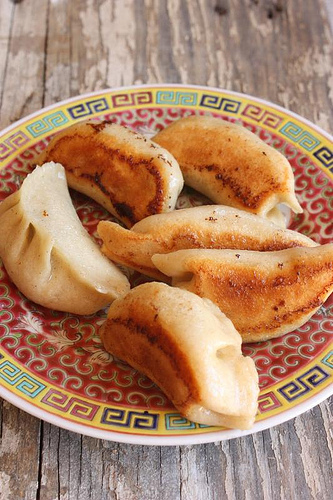
The world of Asian dumplings is vast as the types of dough and fillings that can be used. Soon after the Asian Dumplings cookbook was published in 2009, I received requests for gluten-free dumplings. My response was, “There are many gluten-free Asian dumpling recipes in the book. Check the rice, starch, and legume and tuber chapters for ideas.”
But I quickly realized that the people asking about gluten-free dumplings were specifically interested in making pot stickers (guotie, gyoza). The little panfried morsels are among the most popular, go-to Asian dumpling. So I took a stab at it and the result was so-so. I used an all-purpose gluten-free flour blend by Bob’s Red Mill and posted the hearty results in the form of a gluten-free pot sticker recipe on Asiandumplingtips.com.
Whenever I make a recipe my ultimate question is: Would you proudly serve that to family and friends? With that initial trial run of gluten-free pot stickers, my answer was, frankly, “No!”
My dissatisfaction lingered for over a year and a half. When I had a break from the tofu book a couple weeks ago, I revisited gluten-free pot stickers to see if I could improve my performance. It was matter of crafting a better basic dumpling dough that was devoid of gluten. That’s why this post is trial number 2. Because I ended up experimenting with another dough, I’ll also be posting about trial number 3 this week. Then I’ll do a recap and comparison between the trials.
Blending gluten-free flours & starches
For these dumplings, I decided to fill them with one of my favorites, a classic Chinese pork and napa cabbage filling (Asian Dumplings, page 31). Choose whichever filling that you want from the first chapter of the book because the yield will work for the amount of dough I make below. I prepared a batch of filling and stuck it in the fridge so that I could focus on the dough and test it without fuss.
Instead of purchasing a flour mix, I decided to blend my own. The first dough that I made was based on a gluten-free bread flour mix in Cybele Pascal’s The Allergen-Free Baker’s Handbook: How to bake without gluten, wheat, dairy, eggs, soy, peanuts, tree nuts and sesame. I figured that it covered the gamut and Pascal knew her stuff. She's expert in this area.
The flour blended the following in a 3:3:4:2 ratio: (I’ve included a summary of Pascal’s notes on the flours and starches.)
- Millet flour: mild tasting flour that lends a good ‘wheaty’ flavor
- Sorghum flour: lightly sweet protein-rich flour that’s a good partner for millet in gluten-free breads
- Tapioca starch: versatile and used in both of her flour blends (for dumpling making, I’ve found that tapioca imparts wonderful elasticity and chew)
- Potato starch: creates a tender crumb in baked gluten-free foods (I don’t use potato starch much in dumpling making, though I’ve found it to be extra silky but not as chewy as tapioca)
Sourcing gluten-free flours and starches
I had never cooked with millet or sorghum flour and marched down to the health food store. I found millet flour in the bulk bins section and sorghum flour in the flour aisle in a package by Bob’s Red Mill. (Bob’s also packages millet flour.) Specialty food markets such as Whole Foods carries these kinds of flours too.
Tapioca and potato starch are inexpensive at Asian markets but they’re also sold at health food stores too. (If you are familiar with using millet or sorghum flours, add your insights on how they function and compare to regular all-purpose flour.)
When I looked at the break down of Pascal’s mix, it appeared that the flours contribute flavor while the starches lend stretch. The final ingredient in a lot of gluten-free dough is xantham gum, a plant gum that provides extra structure and elasticity to mimic wheat flour well. Pascal noted that that xantham gum is the gluten-free baker’s friend.
I’d used xantham gum in the first pot sticker trial and knew where to buy it inexpensively: my health food store’s bulk spice section. Xanthan that is sold in the box is about $15 and I didn’t want to invest that much or keep lots of it on hand. If xantham is unavailable, use guar gum, also sold at health food stores with the bulk option being more affordable.
Formulating a gluten-free basic dumpling dough
I weighed my flours and starches and applied Pascal’s mix ratio to come up with my own blend of gluten-free bread flour:
3 ⅜ ounces (¾ cup) millet flour
3 ⅜ ounces (¾ cup) sorghum flour
4 ½ ounces (1 cup) tapioca starch
3 ounces (½ cup) potato starch
Then I measured 10 ounces of the gluten-free bread flour mix into a bowl, added 2 teaspoons of xantham gum (based on a guesstimate) and added my usual ¾ cup of just-boiled water. I mixed the dough by hand until it was smooth and firm-soft.
I pressed my fingers into the lightly speckly dough and of course, it didn’t spring back! Duh, there was no gluten.
Then I let the dough rest in the plastic bag for 30 minutes so that it would soften a tad. Then I rolled it out into wrappers that I filled and shaped. The dough was pretty easy to handle.
The verdict?
I served these gluten-free pot stickers to them to my husband and a friend for lunch. We all thought they were quite good, not overly gummy or doughy. The filling and dipping sauce – made with gluten-free seasonings for the heck of it – were tasty too, though I wanted a little extra oomph by way of regular soy sauce or extra salt. I just followed the recipes in Asian Dumplings and substituted a wheat-free tamari for the soy sauce.
“These are definitely not like your regular pot stickers but if I had to be on a gluten-free diet, I would appreciate having these,” my husband said.
I was happily surprised by the dough’s performance. Pascal’s flour lent a certain toothsome quality and good flavor to the wrapper. The millet and sorghum flours gave the pot stickers a rustic quality. There were hearty but not as much as the first batch of gluten-free dumplings, which reminded me of poorly made whole wheat pasta. This recipe trial number two was far more elegant.
Technical notes on gluten-free dumpling dough
While fiddling around with the dough, I had these realizations about working with gluten-free Asian dumpling dough:
- Gluten-free dough lack elasticity so it is a BREEZE to mix. You don’t get a workout and it comes together quickly. Jus gradually work in the hot water into the flour mix.
- Just like the regular Basic Dumpling Dough (Asian Dumplings, page 22), this gluten-free dough dries easily. Keep it covered while you work.
- When rolling out the dough into wrappers, there’s no need to use a tortilla press as a short cut. Just use your hand to smack the dough into a round disk, then roll each out with the dowel rolling pin.
- Use the extra flour mix to coat the cut pieces of dough and dust your work surface. It’s just like you’d do with regular all-purpose flour.
- The wrapper is not self-sealing. Dip a finger into water and wet half the edge of the wrapper before closing it up.
- The half moon, pea pod, and pleated crescent shapes worked great with this dough. You can shape very clean pleats with this dough.
- Because the dough does not stretch to encase the filling, roll each wrapper to 3 ¼ to 3 ½ inch wide. It will be thin at the edge but you’ll be able to more easily manipulate the dough to close it up around the filling. This dough could be rolled out pretty thinly.
- The dough can be refrigerated overnight in the plastic bag. As usual, return it to room temperature before using.
After this second experiment with gluten-free dumpling dough, I got curious about tweaking the flour mixture. I tried another gluten-free dumpling dough that I’ll write about next.
Related posts:
- Gluten-free Asian Dumpling Dough: How to make the most of it
- Gluten-Free Pot Stickers: Recipe Trial 3 (sorghum, sweet rice, and tapioca starch dough)with tips on working with GF dumpling dough)
- Gluten-free Pot Stickers: Recipe Trial 1 (on Asiandumplingtips.com)
- Guide to Building an Asian Dumpling Pantry
- Tolerance Test: Are Gluten-Free Asian Ingredients for You?
(If you have the enhanced e-version of Asian Dumplings, the technique videos are included)













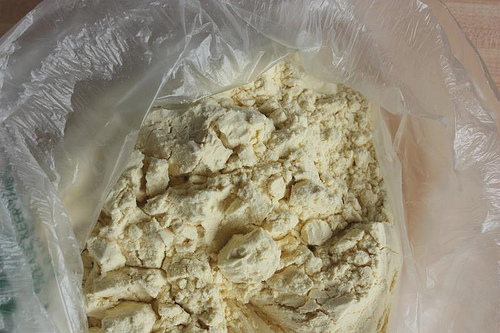
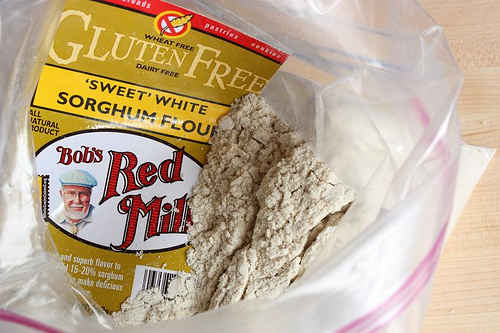
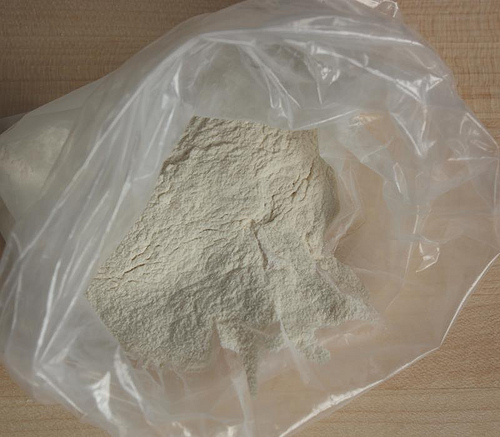
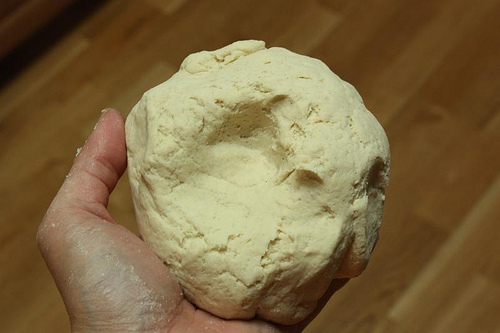
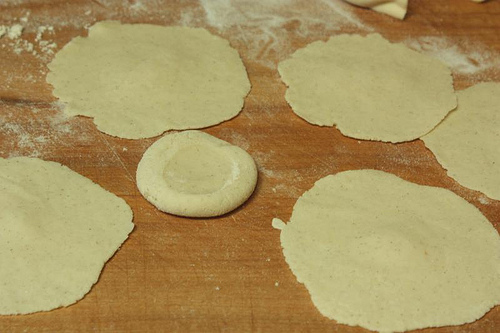
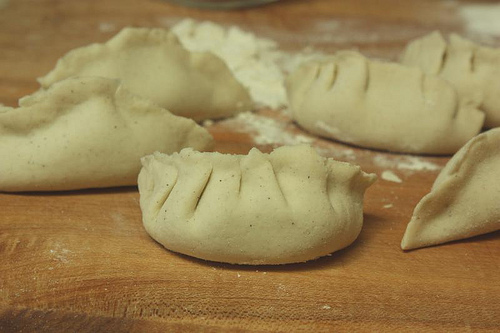




Dave Weinstein says
I've been working on adapting your recipes as well, with the added issue of working within a paleo-diet framework, which means all grains are pretty much out.
The first pass recipe was 5oz of Almond Flour, 2.5oz of Sweet Potato Flour, and 2.5oz of Tapioca Flour. The dough absorbs roughly half as much hot water as the basic dough in your book. The dough was very fragile, and I pretty much pressed it with a Tortilla press and worked from there, rather than rolling it.
It worked well (especially after 7+ months without any dumplings), but it was still around 6g of carbohydrates per dumpling. I'm going to try to reduce the starch amount and compensate with Xanthan Gum (and possibly Agar Agar, which I've had luck with in baking) on the next test batch.
Andrea Nguyen says
Using starches in the dough can heavily weigh them down and loads you up with carbs. Have you tried amaranth flour in addition to the almond flour?
Nut and seed flours are what I've been hearing about as a good alternative for GF food. They're loaded with protein too.
Lori says
This is great! I am looking forward to reading about trial No. 3. I am definitely excited to make some dumplings for my GF niece. She has never had asian dumplings of any kind. Do you think GF trial no. 2 flour would make good soup dumplings? :O)
I will go to the store and get some millet and sorghum flours today. I already have the tapioca and potato starch and xantham gum.
Thanks!
Andrea Nguyen says
Glad this info is useful to you! Trial 3 used a slightly different flour blend.
I could not get the dough to be super thin enough for Shanghai soup dumplings. That satchel shape was the hardest to form from the gluten-free dough because of the lack of stretch. That said, if your niece doesn't mind a not-so-delicate skin on her soup dumpling, that may work for her!
Dave Weinstein says
Pseudo-grains like Amaranth are out too.
I'm considering adding some coconut flour to the mix, and switching to exclusively tapioca for the root starch because it is so sticky.
Time permitting, I'll try a new test batch later this week.
Amy says
This is great and timely. Dumplings (called kreplach) are traditionally served for Yom Kippur this week, and I totally needed a recipe. Thanks. How far in advance can I make these?
men wrist watches says
Crude Palm oil yesterday traded with the negative node and settled -0.96% down at 465 influenced by subdued demand in the spot market and a weak global trend. Also pressuring prices were expectations of seasonal weakness in CPO demand in the October-December quarter as weather turns colder
Andrea Nguyen says
Amy: I have some in the freezer and will let you know how they did in a few days! You can shape the dumplings and keep them on a "floured" parchment paper-lined backing sheet for hours in the fridge. Cover them to avoid drying.
The dough would be great for kreplach!
Andrea Nguyen says
Dave: You are giving up a lot for the Paleo diet. Sorry. ;(
Ugg Outlet says
Do you really have to? The study tentatively recommends that the life-saving kits be issued to “some first responders, health care providers, and other workers that support critical infrastructure, as well as their families.” Apparently medical workers aren’t too stupid to live, according to the Institute of, uh, Medicine. And neither are government workers – those postal workers, the cops that will have to accompany them, and anybody else in government who’s smart enough to call himself a first responder (want to bet that includes the Governor?).
restaurants in Laguna Philippines says
I'm gonna try this one. it sounds interesting for me.
Alvin
Tessa@TessaDomesticDiva says
I happened by your blog via another gluten free blogger...you have made my day!! Your cookbooks are some of my very favorite books that I own. When I had to go gluten free..I have longingly gazed at my Asian Dumplings book, hungering for those luscious little steamed and baked buns. had I known you had a blog...I would have been here AGES ago!! have you worked up any gluten free bun dough yet? I have featured several of your recipes on my blog too...family favorites around this house! Thanks Andrea!
Canada Goose Danmark says
Then you discover what kind of wisdom has accompanied it.
NoreToislesse says
ISOWVDNQAJ uggs on sale ATTEPAZRAG http://jimmievasque24.blogbroad.com/?p=3
Loavielaiconi says
zvaciflsd uggs for sale hwbhpqmaw http://www.artifolio.com/canadagooseoutlet161/30215/uggs-for-sale-uggs-tennis-gloves.html
Beats by Dr Dre says
When one loves one’s art, no service seems too hard.
Beats by dr dre says
We know nothing of what will happen in future , but by the analogy of past experience.
Kim says
can i just use one type of flour and one type of starch??
salvia says
I remember making these before the hubby was diagnosed with Celiacs. It was my best and favorite dish ever. It was definitely something he asked for frequently. I have not made these in YEARS because it just isn’t the same using a gluten free dough vs the thin pasta wrappers. I finally decided to make these one day after much planning and researching. I had to find the right dough before starting, and I did find a recipe that worked well. These have more of a bread taste rather than a pasta taste. But hey, the filling is the same and just as fabulous. If you can live with it, then you will love it. The reason why they are uneven and have strange shapes is because I rolled out the dough all by hand and did not use any kind of cookie cuter or form.
Cathy Truong says
Dear Sir/ Madam,
Glad to meet you,
I am Cathy from SOVIMEX Co., Ltd as a leading exporter of Agri-Products in Vietnam. I am very pleased to offer you our high quality products with competitive price and the best service for your import shipment.
TAPIOCA STARCH
1. Specifications:
- Starch content : 85% Min
- Moisture : 13% Max
- Whiteness : 92% Min
- Impurities : 0.2% Max
- Viscosity : 750 BU Min
- pH : 5 - 7
- Ash content : 0.2% Max
- S02 CONTENT : 30 ppm Max
- Pulp : 0.2ML max.
2. Origin: Vietnam
3. Use: for Food, Textile, Paper industries…
Other conditions as per standard international trade rules.
If you need any additional requirement or quotation, please do not hesitate to contact me by sales7ATsovimexcoDOTcom
Look forward to hearing from you.
Thanks & Best regards,
Cathy (Ms).